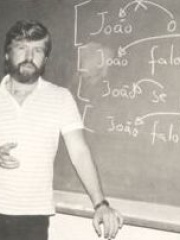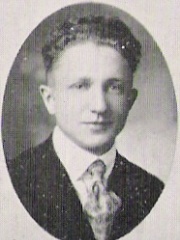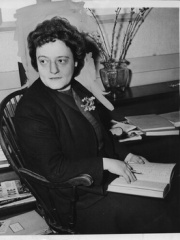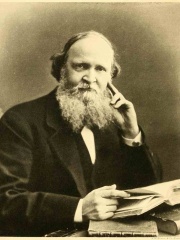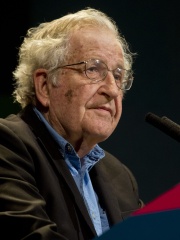
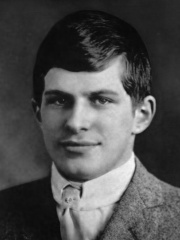


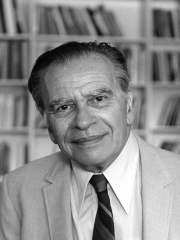
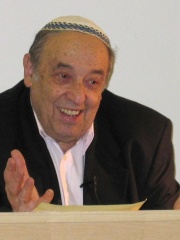

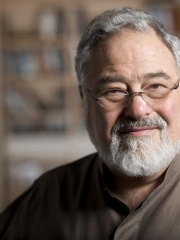
The Most Famous
LINGUISTS from United States
This page contains a list of the greatest American Linguists. The pantheon dataset contains 214 Linguists, 24 of which were born in United States. This makes United States the birth place of the 2nd most number of Linguists.
Top 10
The following people are considered by Pantheon to be the top 10 most legendary American Linguists of all time. This list of famous American Linguists is sorted by HPI (Historical Popularity Index), a metric that aggregates information on a biography's online popularity. Visit the rankings page to view the entire list of American Linguists.

1. Noam Chomsky (b. 1928)
With an HPI of 79.50, Noam Chomsky is the most famous American Linguist. His biography has been translated into 145 different languages on wikipedia.
Avram Noam Chomsky (born December 7, 1928) is an American professor and public intellectual known for his work in linguistics, political activism, and social criticism. Sometimes called "the father of modern linguistics", Chomsky is also a major figure in analytic philosophy and one of the founders of the field of cognitive science. He is a laureate professor of linguistics at the University of Arizona and an institute professor emeritus at the Massachusetts Institute of Technology (MIT). Among the most cited living authors, Chomsky has written more than 150 books on topics such as linguistics, war, and politics. In addition to his work in linguistics, since the 1960s Chomsky has been an influential voice on the American left as a consistent critic of U.S. foreign policy, contemporary capitalism, and corporate influence on political institutions and the media. Born to Ashkenazi Jewish immigrants in Philadelphia, Chomsky developed an early interest in anarchism from alternative bookstores in New York City. He studied at the University of Pennsylvania. During his postgraduate work in the Harvard Society of Fellows, Chomsky developed the theory of transformational grammar for which he earned his doctorate in 1955. That year he began teaching at MIT, and in 1957 emerged as a significant figure in linguistics with his landmark work Syntactic Structures, which played a major role in remodeling the study of language. From 1958 to 1959 Chomsky was a National Science Foundation fellow at the Institute for Advanced Study. He created or co-created the universal grammar theory, the generative grammar theory, the Chomsky hierarchy, and the minimalist program. Chomsky also played a pivotal role in the decline of linguistic behaviorism, and was particularly critical of the work of B. F. Skinner. An outspoken opponent of U.S. involvement in the Vietnam War, which he saw as an act of American imperialism, in 1967 Chomsky rose to national attention for his anti-war essay "The Responsibility of Intellectuals". Becoming associated with the New Left, he was arrested multiple times for his activism and placed on President Richard Nixon's list of political opponents. While expanding his work in linguistics over subsequent decades, he also became involved in the linguistics wars. In collaboration with Edward S. Herman, Chomsky later articulated the propaganda model of media criticism in Manufacturing Consent, and worked to expose the Indonesian occupation of East Timor. His defense of unconditional freedom of speech, including that of Holocaust denial, generated significant controversy in the Faurisson affair of the 1980s. Chomsky's commentary on the Cambodian genocide and the Bosnian genocide also generated controversy. Since retiring from active teaching at MIT, he has continued his vocal political activism, including opposing the 2003 invasion of Iraq and supporting the Occupy movement. An anti-Zionist, Chomsky considers Israel's treatment of Palestinians to be worse than South African–style apartheid, and criticizes U.S. support for Israel. Chomsky is widely recognized as having helped to spark the cognitive revolution in the human sciences, contributing to the development of a new cognitivistic framework for the study of language and the mind. Chomsky remains a leading critic of U.S. foreign policy, contemporary capitalism, U.S. involvement and Israel's role in the Israeli–Palestinian conflict, and mass media. Chomsky and his ideas remain highly influential in the anti-capitalist and anti-imperialist movements. In 2025, Chomsky was revealed to have had a close friendship with convicted child sex offender Jeffrey Epstein.

2. William James Sidis (1898 - 1944)
With an HPI of 78.04, William James Sidis is the 2nd most famous American Linguist. His biography has been translated into 45 different languages.
William James Sidis (; April 1, 1898 – July 17, 1944) was an American child prodigy whose exceptional abilities in mathematics and languages made him one of the most famous intellectual prodigies of the early 20th century. Born to Boris Sidis, a prominent psychiatrist, and Sarah Mandelbaum Sidis, a physician, Sidis demonstrated extraordinary intellectual capabilities from infancy. Enrolled at Harvard University at age 11, he delivered a widely publicized lecture on four-dimensional geometry at age 12 and graduated cum laude in 1914 at 16. Despite his early academic success, Sidis deliberately withdrew from public attention following his imprisonment during the First Red Scare and spent the remainder of his life working in anonymity while pursuing private scholarly interests. His extensive writings under various pseudonyms covered topics ranging from cosmology and mathematics to Native American history and urban transportation systems. His unsuccessful privacy lawsuit against The New Yorker magazine in the 1930s established important precedents in American privacy law. Sidis has become, in the words of historian Ann Hulbert, "a cautionary tale in every debate about gifted children," representing both the potential and perils of exceptional intellectual precocity.

3. Noah Webster (1758 - 1843)
With an HPI of 77.96, Noah Webster is the 3rd most famous American Linguist. His biography has been translated into 46 different languages.
Noah Webster (October 16, 1758 – May 28, 1843) was an American lexicographer, textbook pioneer, English-language spelling reformer, political writer, editor, and author. He has been called the "Father of American Scholarship and Education". He authored a large number of "Blue-Back Speller" books which were used to teach American children how to spell and read. He is also the author for the modern Merriam-Webster dictionary that was first published in 1828 as An American Dictionary of the English Language. Born in West Hartford, Connecticut, Webster graduated from Yale College in 1778. He passed the bar examination after studying law under Oliver Ellsworth and others but was unable to find work as a lawyer. He found some financial success by opening a private school and writing a series of educational books, including the "Blue-Back Speller". A strong supporter of the American Revolution and the ratification of the United States Constitution, Webster later criticized American society as being in need of an intellectual foundation. He believed American nationalism had distinctive qualities that differed from European values. In 1793, Alexander Hamilton recruited Webster to move to New York City and become an editor for a Federalist Party newspaper. He became a prolific author, publishing newspaper articles, political essays, and textbooks. He returned to Connecticut in 1798 and served in the Connecticut House of Representatives. Webster founded the Connecticut Society for the Abolition of Slavery in 1791 but later became somewhat disillusioned with the abolitionist movement. In 1806, Webster published his first dictionary, A Compendious Dictionary of the English Language. The following year, he started working on an expanded and comprehensive dictionary, finally publishing it in 1828. He was influential in popularizing certain American spellings. He played a role in advocating for copyright reform, contributing to the Copyright Act of 1831, the first major statutory revision of U.S. copyright law. While working on a second volume of his dictionary, Webster died in 1843, and the rights to the dictionary were acquired by George and Charles Merriam.

4. Leonard Bloomfield (1887 - 1949)
With an HPI of 74.58, Leonard Bloomfield is the 4th most famous American Linguist. His biography has been translated into 44 different languages.
Leonard Bloomfield (April 1, 1887 – April 18, 1949) was an American linguist who led the development of structural linguistics in the United States during the 1930s and '40s. He is considered to be the father of American distributionalism. His influential textbook Language, published in 1933, presented a comprehensive description of American structural linguistics. He made significant contributions to Indo-European historical linguistics, the description of Austronesian languages, and description of languages of the Algonquian family. Bloomfield's approach to linguistics was characterized by its emphasis on the scientific basis of linguistics and emphasis on formal procedures for the analysis of linguistic data. The influence of Bloomfieldian structural linguistics declined in the late 1950s and 1960s as the theory of generative grammar developed by Noam Chomsky came to predominate.

5. Benjamin Lee Whorf (1897 - 1941)
With an HPI of 66.77, Benjamin Lee Whorf is the 5th most famous American Linguist. His biography has been translated into 44 different languages.
Benjamin Atwood Lee Whorf (; April 24, 1897 – July 26, 1941) was an American linguist and fire prevention engineer best known for proposing the Sapir–Whorf hypothesis. He believed that the structures of different languages shape how their speakers perceive and conceptualize the world. Whorf saw this idea, named after him and his mentor Edward Sapir, as having implications similar to those of Einstein's principle of physical relativity. However, the concept originated from 19th-century philosophy and thinkers like Wilhelm von Humboldt and Wilhelm Wundt. Whorf initially pursued chemical engineering but developed an interest in linguistics, particularly Biblical Hebrew and indigenous Mesoamerican languages. His groundbreaking work on the Nahuatl language earned him recognition, and he received a grant to study it further in Mexico. He presented influential papers on Nahuatl upon his return. Whorf later studied linguistics with Edward Sapir at Yale University while working as a fire prevention engineer. During his time at Yale, Whorf worked on describing the Hopi language and made notable claims about its perception of time. He also conducted research on the Uto-Aztecan languages, publishing influential papers. In 1938, he substituted for Sapir, teaching a seminar on American Indian linguistics. Whorf's contributions extended beyond linguistic relativity; he wrote a grammar sketch of Hopi, studied Nahuatl dialects, proposed a deciphering of Maya hieroglyphic writing, and contributed to Uto-Aztecan reconstruction. After Whorf's premature death from cancer in 1941, his colleagues curated his manuscripts and promoted his ideas regarding language, culture, and cognition. However, in the 1960s, his views fell out of favor due to criticisms claiming his ideas were untestable and poorly formulated. In recent decades, interest in Whorf's work has resurged, with scholars reevaluating his ideas and engaging in a more in-depth understanding of his theories. The field of linguistic relativity remains an active area of research in psycholinguistics and linguistic anthropology, generating ongoing debates between relativism and universalism, as well as in the study of raciolinguistics. Whorf's contributions to linguistics, such as the allophone and the cryptotype, have been widely accepted.

6. Joseph Greenberg (1915 - 2001)
With an HPI of 65.87, Joseph Greenberg is the 6th most famous American Linguist. His biography has been translated into 39 different languages.
Joseph Harold Greenberg (May 28, 1915 – May 7, 2001) was an American linguist, known mainly for his work concerning linguistic typology and the genetic classification of languages.

7. Joshua Fishman (1926 - 2015)
With an HPI of 65.81, Joshua Fishman is the 7th most famous American Linguist. His biography has been translated into 27 different languages.
Joshua Fishman (Yiddish: שיקל פֿישמאַן — Shikl Fishman; July 18, 1926 – March 1, 2015) was an American linguist who specialized in the sociology of language, language planning, bilingual education, and language and ethnicity.

8. William Labov (1927 - 2024)
With an HPI of 64.13, William Labov is the 8th most famous American Linguist. His biography has been translated into 29 different languages.
William David Labov ( lə-BOHV; December 4, 1927 – December 17, 2024) was an American linguist widely regarded as the founder of the discipline of variationist sociolinguistics. He has been described as "an enormously original and influential figure who has created much of the methodology" of sociolinguistics, and "one of the most influential linguists of the 20th and 21st centuries". Labov was a professor in the linguistics department of the University of Pennsylvania in Philadelphia and pursued research in sociolinguistics, language change, and dialectology. He retired in 2015 but continued to publish research until his death in 2024.

9. George Lakoff (b. 1941)
With an HPI of 63.75, George Lakoff is the 9th most famous American Linguist. His biography has been translated into 32 different languages.
George Philip Lakoff ( LAY-kawf; born May 24, 1941) is an American cognitive linguist and philosopher, best known for his thesis that people's lives are significantly influenced by the conceptual metaphors they use to explain complex phenomena. Lakoff served as professor of linguistics at the University of California, Berkeley, from 1972 until his retirement in 2016. The conceptual metaphor thesis, introduced in his and Mark Johnson's 1980 book Metaphors We Live By has found applications in a number of academic disciplines. Applying it to politics, literature, philosophy and mathematics has led Lakoff into territory normally considered basic to political science. In his 1996 book Moral Politics, Lakoff described conservative voters as being influenced by the "strict father model" as a central metaphor for such a complex phenomenon as the state, and liberal/progressive voters as being influenced by the "nurturant parent model" as the folk psychological metaphor for this complex phenomenon. According to him, an individual's experience and attitude towards sociopolitical issues is influenced by being framed in linguistic constructions. In Metaphor and War: The Metaphor System Used to Justify War in the Persian Gulf (1991), he argues that the American involvement in the Persian Gulf War was obscured or "spun" by the metaphors which were used by the first Bush administration to justify it. Between 2003 and 2008, Lakoff was involved with a progressive think tank, the now defunct Rockridge Institute. Lakoff is a member of the scientific committee of the Fundación IDEAS (IDEAS Foundation), Spain's Socialist Party's think tank. The more general theory that elaborated his thesis is known as embodied mind. His first marriage was to linguist Robin Lakoff.
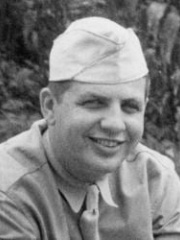
10. Morris Swadesh (1909 - 1967)
With an HPI of 61.69, Morris Swadesh is the 10th most famous American Linguist. His biography has been translated into 36 different languages.
Morris Swadesh ( SWAH-desh; January 22, 1909 – July 20, 1967) was an American linguist who specialized in comparative and historical linguistics, and developed his mature career at UNAM in Mexico. Swadesh was born in Massachusetts to Bessarabian Jewish immigrant parents. He completed bachelor's and master's degrees at the University of Chicago, studying under Edward Sapir, and then followed Sapir to Yale University where he completed a Ph.D. in 1933. Swadesh taught at the University of Wisconsin–Madison from 1937 to 1939, and then during World War II worked on projects with the United States Army and Office of Strategic Services. He became a professor at the City College of New York after the war's end, but was fired in 1949 due to his membership in the Communist Party. He spent most of the rest of his life teaching in Mexico and Canada. Swadesh had a particular interest in the indigenous languages of the Americas, and conducted extensive fieldwork throughout North America. He was one of the pioneers of glottochronology and lexicostatistics, and is known for his creation of the Swadesh list, a compilation of basic concepts believed to present across cultures and thus suitable for cross-linguistic comparison. Swadesh believed that his techniques could discover deep relationships between apparently unrelated languages, thus allowing for the identification of macrofamilies and possibly even a "Proto-Human" language. His theories were often controversial, and some have been deprecated by later linguists.
People
Pantheon has 24 people classified as American linguists born between 1758 and 1951. Of these 24, 5 (20.83%) of them are still alive today. The most famous living American linguists include Noam Chomsky, George Lakoff, and Stephen Krashen. The most famous deceased American linguists include William James Sidis, Noah Webster, and Leonard Bloomfield.
Living American Linguists
Go to all RankingsNoam Chomsky
1928 - Present
HPI: 79.50
George Lakoff
1941 - Present
HPI: 63.75
Stephen Krashen
1941 - Present
HPI: 59.19
Daniel Everett
1951 - Present
HPI: 53.22
Lyle Campbell
1942 - Present
HPI: 51.18
Deceased American Linguists
Go to all RankingsWilliam James Sidis
1898 - 1944
HPI: 78.04
Noah Webster
1758 - 1843
HPI: 77.96
Leonard Bloomfield
1887 - 1949
HPI: 74.58
Benjamin Lee Whorf
1897 - 1941
HPI: 66.77
Joseph Greenberg
1915 - 2001
HPI: 65.87
Joshua Fishman
1926 - 2015
HPI: 65.81
William Labov
1927 - 2024
HPI: 64.13
Morris Swadesh
1909 - 1967
HPI: 61.69
George Kingsley Zipf
1902 - 1950
HPI: 58.47
William Stokoe
1919 - 2000
HPI: 56.14
Alice Kober
1906 - 1950
HPI: 55.67
William Dwight Whitney
1827 - 1894
HPI: 55.63
Overlapping Lives
Which Linguists were alive at the same time? This visualization shows the lifespans of the 18 most globally memorable Linguists since 1700.


